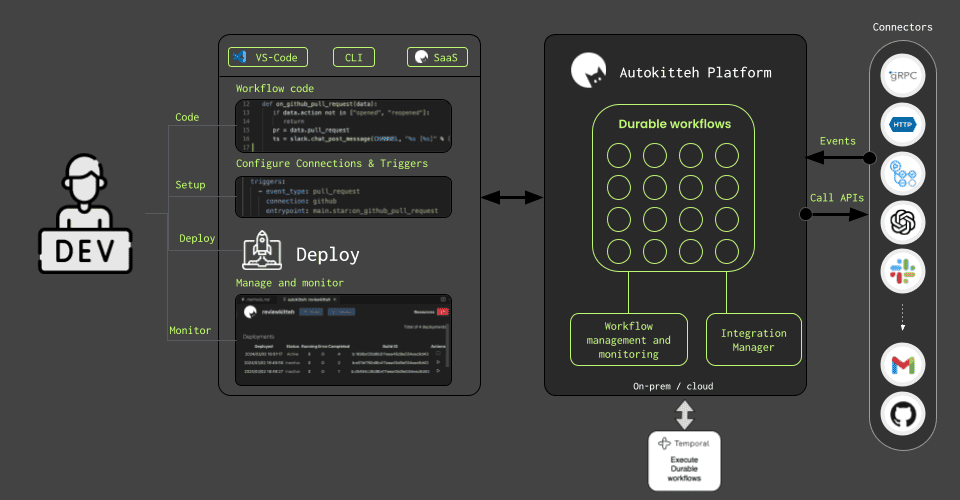A Developer's Guide to Intelligent Workflow Automation
Intelligent workflow automation is not easy and requires a great deal of planning, implementation, and optimization. Here are the steps to fully automate your company’s workflow.
Step 1: Identify and Prioritize Processes to Optimize
Start by identifying processes that are repetitive, time-consuming, and prone to errors. For example:
Processes like receiving orders, updating inventory, and sending shipping notifications.
Tasks like document verification, account creation, and onboarding emails.
Actionable Tips
Use the Pareto principle: Focus on automating the 20% of processes that create 80% of the inefficiencies.
Rank by ROI: Assess the time and cost for each process to prioritize effectively.
Involve stakeholders: Work with department leads to identify the most pressing bottlenecks.
Review metrics: Measure task frequency and manual effort to determine which processes will deliver immediate results.
Step 2: Map and Document Workflows
Before implementing intelligent process automation, map the existing workflows step by step. It helps to identify inputs, outputs, dependencies, and bottlenecks to create a clear blueprint of the automation process. For example, an invoice processing flow can be mapped like this:
Receive invoice
Validate data (e.g., amount, vendor details)
Approve payment
Update accounting systems
Send payment confirmation
Actionable Tips
Use visualization tools: Use tools like Lucidchart or Microsoft Visio to create clear workflow diagrams.
Include key stakeholders: Engage team members who handle the process daily to ensure accuracy.
Identify bottlenecks: Highlight inefficiencies or delays in the current process.
Review end-to-end flow: Map processes from start to finish, including inputs, decisions, and outcomes.
Step 3: Define Automation Objectives
Defining what you want to accomplish with intelligent process automation is important. You need to align automation objectives with broader business goals to maximize value. However, each organization may have different objectives, such as:
Reducing errors
Saving time
Cutting costs
Improving customer experience
For instance, when automating an order management workflow, you can set a goal to cut order shipping time by 50% and provide inventory counts in real time.
Actionable Tips
Set SMART goals: Ensure objectives are Specific, Measurable, Achievable, Relevant, and Time-bound.
Align with KPIs: Define success metrics such as reduced error rates, faster task completion, or cost savings.
Focus on business impact: Prioritize objectives that address critical pain points.
Track progress: Continuously monitor the objectives to measure how automation improves efficiency.
Step 4: Choose the Right Platform
Next, you need to select the right automation platform for your requirements. It’s a good idea to select easy-to-use tools like low–code platforms, which offer high flexibility and scalability and allow teams to build and customize workflows with minimal coding experience.
For example, AutoKitteh is a great low-code workflow automation and orchestration platform tailored for developers. Simply by writing the business logic, you can create intelligent workflow automation for unlimited organizational requirements. AutoKitteh takes care of everything under the hood, such as scalability, secrets management, and monitoring.
Actionable Tips
Evaluate integration capabilities: Ensure the platform integrates with your existing tools and systems.
Prioritize user-friendly tools: Choose low-code platforms with drag-and-drop interfaces to speed up adoption.
Test for scalability: Select platforms that can scale with your organization as it grows.
Step 5: Test and Optimize the Workflows
Start by running thorough tests on a small scale before full deployment. This approach allows you to gather real-world feedback and refine automation without impacting business operations.
Actionable Tips
Simulate real scenarios: Run tests under real-world conditions to ensure workflows operate smoothly.
Track KPIs: Measure performance metrics like task duration, error rates, and success rates.
Iterate and improve: Use feedback to make incremental improvements before scaling.
Step 6: Deploy the Automation
Once testing is complete, roll out the intelligent workflow automation across the organization. This stage involves careful monitoring to ensure the automation performs as expected and delivers the desired benefits.
Actionable Tips
Gradual deployment: Roll out automation in stages to reduce risks and allow for adjustments.
Communicate rollout plans: Keep stakeholders informed about deployment timelines and goals.
Establish monitoring metrics: Define key performance indicators (KPIs) to track the effectiveness of the automation. The KPIs may include time saved, error reduction, or cost savings.
Performance analysis: Regularly analyze the monitoring data to identify areas for improvement and optimization, such as fine-tuning the automation rules and adjusting workflows.
Step 7: Train Employees
Provide clear and concise training sessions to help employees understand and manage the new automated workflows. Focus on the benefits of automation, such as saving time on repetitive tasks, improving accuracy, and freeing up bandwidth for higher-value work.
Actionable Tips
Interactive training: Use workshops or simulations for hands-on learning.
Express value: Put as much value and emphasis on automation training as you would for other sessions like phishing awareness.
Create resource guides: Develop easy-to-follow manuals, videos, or FAQs for ongoing support.
Gather feedback: Continuously collect feedback to improve training and workflows further.
Create Any Workflow with AutoKitteh
Intelligent workflow automation is the ultimate driver for your organization’s future success. Although creating an automation workflow from scratch can be challenging, selecting the right platform can make your work much easier.
AutoKitteh stands out as an ideal choice for businesses with complex automation requirements. With its serverless architecture, AutoKitteh takes care of infrastructure, scalability, and monitoring so you can focus on building workflows tailored to your needs.
AutoKitteh enables developers to create durable, long-running workflows that automatically resume after failures. It also handles secrets management, authentication, and logging under the hood, simplifying workflow creation without sacrificing power or flexibility.
Try AutoKitteh’s capabilities today to future-proof your business operations.



